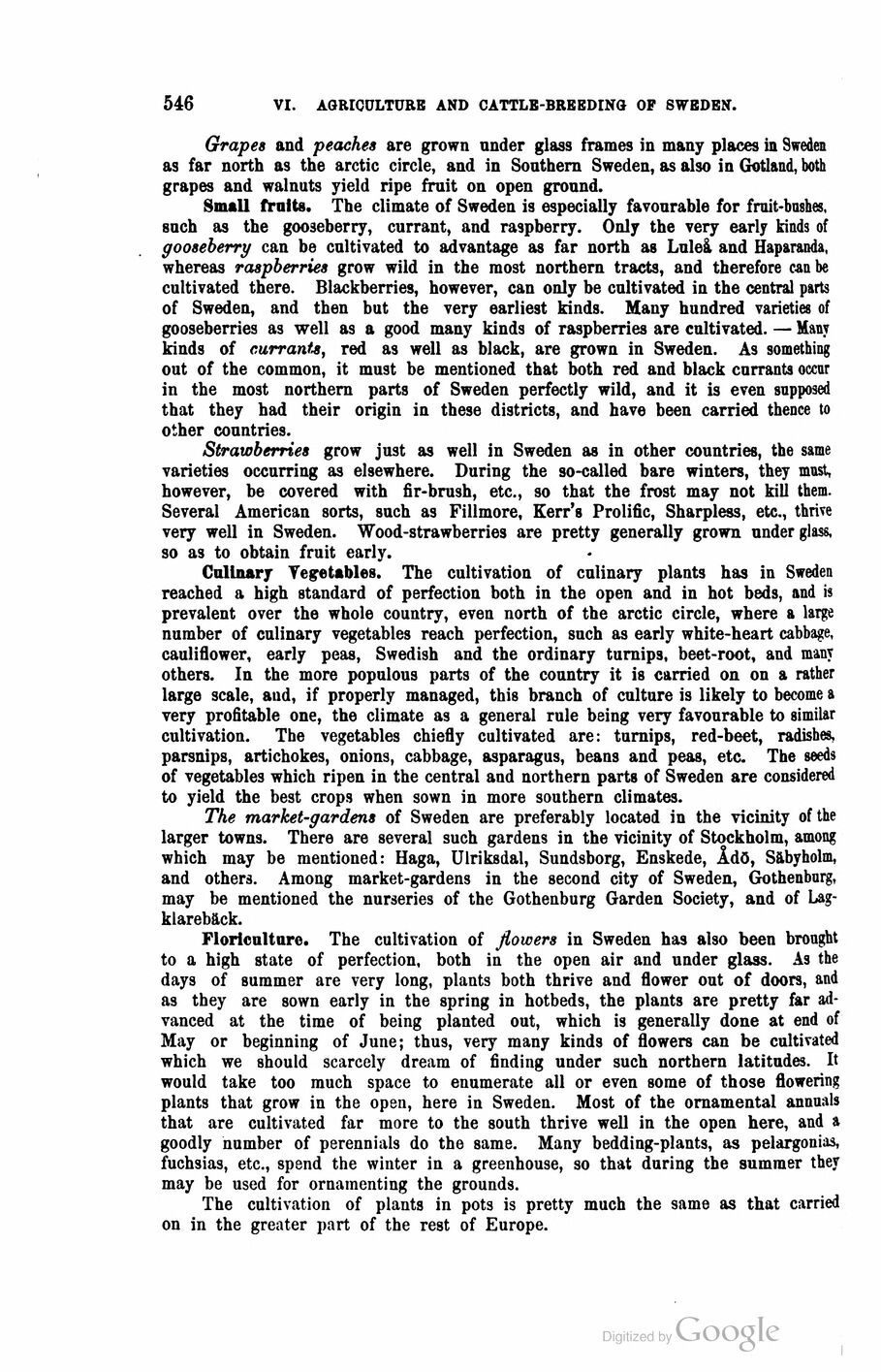
Full resolution (JPEG) - On this page / på denna sida - Second part - VI. Agriculture and Cattle-Breeding - 1. Agriculture. Partly after information from P. Lundell, Ebbetorp, Member of the Riksdag - Horticulture and Floriculture, after Director E. Lindgren, Tumba, and Director Aug. P. Andersson, Stockholm

<< prev. page << föreg. sida << >> nästa sida >> next page >>
Below is the raw OCR text
from the above scanned image.
Do you see an error? Proofread the page now!
Här nedan syns maskintolkade texten från faksimilbilden ovan.
Ser du något fel? Korrekturläs sidan nu!
This page has never been proofread. / Denna sida har aldrig korrekturlästs.
546
VI. AGRICULTURE AND CATTLE-BREEDING OF SWEDEN.
Grapes and peaches are grown under glass frames in many places in Sweden
as far north as the arctic circle, and in Southern Sweden, as also in Gotland, both
grapes and walnuts yield ripe fruit on open ground.
Small fruits. The climate of Sweden is especially favourable for fruit-bushes,
such as the gooseberry, currant, and raspberry. Only the very early kinds of
gooseberry can be cultivated to advantage as far north as Luleå and Haparanda,
whereas raspberries grow wild in the most northern tracts, and therefore can be
cultivated there. Blackberries, however, can only be cultivated in the central parts
of Sweden, and then but the very earliest kinds. Many hundred varieties of
gooseberries as well as a good many kinds of raspberries are cultivated. — Maw
kinds of currant*, red as well as black, are grown in Sweden. As something
out of the common, it must be mentioned that both red and black currants occur
in the most northern parts of Sweden perfectly wild, and it is even supposed
that they had their origin in these districts, and have been carried thence to
other countries.
Strawberries grow just as well in Sweden as in other countries, the same
varieties occurring as elsewhere. During the so-called bare winters, they mast,
however, be covered with fir-brush, etc., so that the frost may not kill them.
Several American sorts, such as Fillmore, Kerr’s Prolific, Sharpless, etc., thrive
very well in Sweden. Wood-strawberries are pretty generally grown under glass,
so as to obtain fruit early.
Culinary Vegetables. The cultivation of culinary plants has in Sweden
reached a high standard of perfection both in the open and in hot beds, and is
prevalent over the whole country, even north of the arctic circle, where a large
number of culinary vegetables reach perfection, such as early white-heart cabbage,
cauliflower, early peas, Swedish and the ordinary turnips, beet-root, and many
others. In the more populous parts of the country it is carried on on a rather
large scale, and, if properly managed, this branch of culture is likely to become a
very profitable one, the climate as a general rule being very favourable to similar
cultivation. The vegetables chiefly cultivated are: turnips, red-beet, radishes,
parsnips, artichokes, onions, cabbage, asparagus, beans and peas, etc. The seeds
of vegetables which ripen in the central and northern parts of Sweden are considered
to yield the best crops when sown in more southern climates.
The market-gardens of Sweden are preferably located in the vicinity of the
larger towns. There are several such gardens in the vicinity of Stockholm, among
which may be mentioned: Haga, Ulriksdal, Sundsborg, Enskede, Ådö, Säbyholm,
and others. Among market-gardens in the second city of Sweden, Gothenburg,
may be mentioned the nurseries of the Gothenburg Garden Society, and of
Lag-klarebäck.
Floriculture. The cultivation of flowers in Sweden has also been brought
to a high state of perfection, both in the open air and under glass. As the
days of summer are very long, plants both thrive and flower out of doors, and
as they are sown early in the spring in hotbeds, the plants are pretty far
advanced at the time of being planted out, which is generally done at end of
May or beginning of June; thus, very many kinds of flowers can be cultivated
which we should scarcely dream of finding under such northern latitudes. It
would take too much space to enumerate all or even some of those flowering
plants that grow in the open, here in Sweden. Most of the ornamental annuals
that are cultivated far more to the south thrive well in the open here, and a
goodly number of perennials do the same. Many bedding-plants, as pelargonias,
fuchsias, etc., spend the winter in a greenhouse, so that during the summer they
may be used for ornamenting the grounds.
The cultivation of plants in pots is pretty much the same as that carried
on in the greater part of the rest of Europe.
<< prev. page << föreg. sida << >> nästa sida >> next page >>